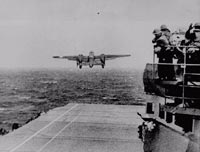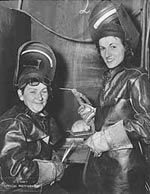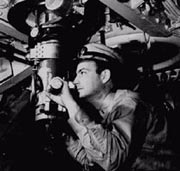| (insert your NIE or newspaper logo here) |
Weekly Online LessonOnline Lesson ArchiveGrade Level: 6-10
|
Remembering World War II
 Over the last several months, news and photos have focused attention on soldiers, prisoners of war, and other concerns in Iraq. But over the next couple of weeks, several events will remind Americans of the heroes, horrors, and triumphs of a different war: World War II.
Over the last several months, news and photos have focused attention on soldiers, prisoners of war, and other concerns in Iraq. But over the next couple of weeks, several events will remind Americans of the heroes, horrors, and triumphs of a different war: World War II.
On Saturday, May 29, 2004, World War II veterans will be honored by the dedication of a memorial in Washington D.C., nearly 60 years after the war's end.
This formal recognition of their efforts and sacrifice comes just in time for the 60th anniversary of D-Day on June 6 -- the day American and British soldiers joined together to invade Europe and push back Adolf Hitler's forces. This initiative marked the beginning of the end for the powerful Axis alliance.
 About 16 million Americans served in World War II from1941 to 1945. Now in their 70s and 80s, fewer than 4 million of these veterans are alive today. Many hope the new monument will help remind future generations of how that war shaped America.
About 16 million Americans served in World War II from1941 to 1945. Now in their 70s and 80s, fewer than 4 million of these veterans are alive today. Many hope the new monument will help remind future generations of how that war shaped America.
Ultimately, war not only affects individual soldiers but entire nations. During the Second World War, for example, thousands of soldiers were injured or lost their lives, while civilians on the home front dealt with rationing of food, fuel, and materials, as well as shifts in gender roles.
This week's lesson will focus on American involvement in World War II, from 1941 to 1945 -- exploring what the war was like for political leaders, soldiers and civilians.
America Joins Perilous Fight
 Struggling for renewal following the Great Depression and the Dust Bowl of the early 1930s, the U.S. hoped to stay focused on domestic growth and keep out of conflicts overseas. But after the surprise attack on Pearl Harbor, the nation demanded action.
Struggling for renewal following the Great Depression and the Dust Bowl of the early 1930s, the U.S. hoped to stay focused on domestic growth and keep out of conflicts overseas. But after the surprise attack on Pearl Harbor, the nation demanded action.
Begin exploring this Perilous Fight at PBS. First, View WWII Timeline, and Launch Timeline (Flash required).
Brush up on what led to American involvement in the war by browsing the timeline from 1933 to 1940. Click on underlined dates and headlines for more information about each event.
What exactly were the steps in Hitler's rise to power? What were leaders in Japan, Italy, Spain, and Soviet Russia doing at the time? What year did the U.S. Congress approve rearmament? How far had Hitler's forces spread by the end of 1940?
Continue through the timeline from 1940 through 1945. Why do you think U.S. President Roosevelt wanted to censor letters going overseas? What was the Bataan Death March? Why was there a ban on sliced bread? What happened at the Battle of the Bulge? What was Trinity?
Close the timeline interactive window, and go visit The Battlefield. In each section, open the Letters, Color Photos, Videos (RealPlayer required), and Maps.
Start with Pearl Harbor and The Doolittle Raid & Midway. About how far away are these locations relative to Japan and the continental U.S.? What key events occurred at each of these places? How did those events influence the war, as well as national morale?
 Also read about Building An Army and The Secret War. What were some of the challenges the U.S. faced in going to war at this time? Why were spy efforts crucial?
Also read about Building An Army and The Secret War. What were some of the challenges the U.S. faced in going to war at this time? Why were spy efforts crucial?
Now uncover The Psychology of War, and peer into the files of The Atomic Option, Disbelief of Atrocities, Letters from the Front, The Kamikaze Threat, and The Mental Toll. How would you describe the effects these had on soldiers or the war in general?
It wasn't all quiet on the Home Front either. Here, we were feeling the effects of other forces: American Industrialization, Isolationism, Financing the War, and Censorship. Plus, Americans Were On the Move.
What were some of the benefits of war? What were some of the costs? How do you think these affected how Americans viewed or felt about the war?
Of course, the war shaped other Social Aspects of American life. For example, find out how the war affected African Americans, Asian Americans, Women, Conscientious Objectors, and Anti-Semitism in the U.S.
In what specific ways -- in society, industry, politics, law, and demographics -- did America's participation in the war influence its future?
D-Day
 D-Day, the launching of Operation Overlord, marked an important turn in World War II. So to explore what happened and why, let's travel to The History Channel site, D-Day: Sixtieth Anniversary.
D-Day, the launching of Operation Overlord, marked an important turn in World War II. So to explore what happened and why, let's travel to The History Channel site, D-Day: Sixtieth Anniversary.
Begin your time travel at the D-Day Timeline. Read the introduction to The Invasion, then continue through the hours when Airborne Landing Begins, the Allies start their Heavy Bombing Raids, the Landings by American, British, and Canadian troops, and how D-Day Ends.
Now visit the Multimedia section to view some of the day's related photos. Also, Watch World War II Film Footage (link below photo gallery thumbnails) on WWII Figureheads, the United States, Germany, Japan/Pacific, Europe, and Russia.
 Who were some of the important people involved in the Allied invasion and other strategic strikes or defensive maneuvers? In what ways were these battles different than battles American soldiers face today? How are they similar?
Who were some of the important people involved in the Allied invasion and other strategic strikes or defensive maneuvers? In what ways were these battles different than battles American soldiers face today? How are they similar?
Lastly, let's check out the American Experience: D-Day at PBS, and find out -- Did You Know? So how many Allied soldiers landed on the shores of Normandy? What does the "D" in D-Day stand for?
Also, hear about the war from some of The Voices of D-Day, Hot Off the Presses, and through Letters from the Front. How are the viewpoints of the war different from each other, depending on the storyteller's style and purpose, as well as the conditions under which each account was written?
Newspaper Activities
Over the next couple of weeks, watch for World War II articles in Targetnewspaper. Some of them may be personal accounts by veterans. If so, what stories do they tell? In what way was each person's experience unique? What commonalities are there? You might also find a news story highlighting an event honoring World War II veterans, or an art or photo gallery display featuring historical war images. Do you have a relative or know anyone in your town or neighborhood who lived during World War II? If so, consider asking them about their own personal stories. Record and share them with others, if the sources don't mind!
© Copyright 2004
Learners
Online,
Inc.
